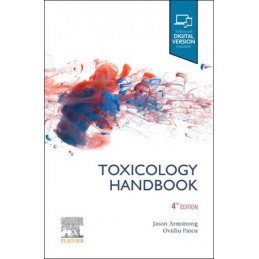- Obniżka


 Dostawa
Dostawa
Wybierz Paczkomat Inpost, Orlen Paczkę, DHL, DPD, Pocztę, email (dla ebooków). Kliknij po więcej
 Płatność
Płatność
Zapłać szybkim przelewem, kartą płatniczą lub za pobraniem. Kliknij po więcej szczegółów
 Zwroty
Zwroty
Jeżeli jesteś konsumentem możesz zwrócić towar w ciągu 14 dni*. Kliknij po więcej szczegółów
Now in its fourth edition, the Toxicology Handbook is Australias leading reference guide for quick and evidence-informed decision making on treatment of the acutely poisoned patient.
The book has been streamlined and fully updated to provide a comprehensive yet concise guide for all medical practitioners and health-care professionals who deal with poisonings. It contains quickly accessible information on poisons, toxins, antidotes, envenomings and antivenoms, and uses a structured and rigorous risk assessment-based approach to guide appropriate treatment decisions.
Written by leading Australian specialists in toxicology and informed by the latest clinical research, this is a must-have addition to all emergency departments and poison information centres.
Opis
CHAPTER 1 APPROACH TO THE POISONED PATIENT
1.1 Overview
1.2 Resuscitation
1.3 Risk assessment
1.4 Supportive care and monitoring
1.5 Investigations
1.6 Gastrointestinal decontamination
1.7 Enhanced elimination
1.8 Antidotes
1.9 Description
CHAPTER 2 SPECIFIC CONSIDERATIONS
2.1 Coma
2.2 Hypotension
2.3 Seizures
2.4 Approach to delirium
2.5 Serotonin toxicity
2.6 Anticholinergic toxicity
2.7 Cholinergic toxicity
2.8 Neuroleptic malignant syndrome
2.9 Alcohol use disorder
2.10 Amphetamine use disorder
2.11 Opioid use disorder
2.12 Sedative-hypnotic use disorder
2.13 Solvent abuse
2.14 Body packers and stuffers
2.15 Osmolar gap
2.16 Acid-base disorders
2.17 The 12-lead ECG in toxicology
2.18 Approach to mushroom poisoning
2.19 Approach to plant poisoning
2.20 Poisoning during pregnancy and lactation
2.21 Poisoning in children
2.22 Poisoning in the elderly
CHAPTER 3 SPECIFIC TOXINS
3.1 Alcohol: Ethanol
3.2 Alcohol: Ethylene glycol
3.3 Alcohol: Isopropanol (isopropyl alcohol)
3.4 Alcohol: Methanol (methyl alcohol)
3.5 Alcohol: Other toxic alcohols
3.6 Amisulpride
3.7 Amphetamines and amphetamine-like substances
3.8 Angiotensin-converting enzyme inhibitors (ACEIs) and angiotensin II receptor blockers (ARBs)
3.9 Anticoagulant rodenticides
3.10 Anticonvulsants: Newer agents
3.11 Antihistamines (non-sedating)
3.12 Antihistamines (sedating)
3.13 Arsenic
3.14 Baclofen
3.15 Barbiturates
3.16 Benzodiazepines
3.17 Benztropine
3.18 Beta-blockers
3.19 Bupropion
3.20 Button batteries
3.21 Calcium channel blockers (CCBs)
3.22 Cannabinoids and synthetic cannabinoid receptor agonists (SCRAs)
3.23 Carbamazepine
3.24 Carbon monoxide
3.25 Chloroquine and hydroxychloroquine
3.26 Chloral hydrate
3.27 Clonidine and other central ?2-adrenergic agonists
3.28 Clozapine
3.29 Cocaine
3.30 Colchicine
3.31 Corrosives
3.32 Cyanide
3.33 Digoxin: Acute overdose
3.34 Digoxin: Chronic poisoning
3.35 Diphenoxylate-atropine
3.36 Direct oral anticoagulants
3.37 Gamma-hydroxybutyrate (GHB)
3.38 Glyphosate
3.39 Hydrocarbons
3.40 Hydrofluoric acid
3.41 Hydrogen peroxide
3.42 Insulin
3.43 Iron
3.44 Isoniazid
3.45 Lamotrigine
3.46 Lead
3.47 Lithium: Acute overdose
3.48 Lithium: Chronic poisoning
3.49 Local anaesthetic agents
3.50 Mercury
3.51 Metformin
3.52 Methotrexate
3.53 Mirtazapine
3.54 Monoamine oxidase inhibitors (MAOIs)
3.55 Non-steroidal anti-inflammatory drugs (NSAIDs)
3.56 Olanzapine
3.57 Opioids
3.58 Organochlorines
3.59 Organophosphorus agents (organophosphates and carbamates)
3.60 Paracetamol: Immediate-release preparations (acute overdose)
3.61 Paracetamol: Modified-release formulations
3.62 Paracetamol: Repeated supratherapeutic ingestion
3.63 Paraquat
3.64 Phenothiazines and butyrophenones (antipsychotic agents)
3.65 Phenytoin
3.66 Potassium chloride
3.67 Pregabalin
3.68 Quetiapine
3.69 Quinine
3.70 Risperidone
3.71 Salicylates
3.72 Selective serotonin reuptake inhibitors (SSRIs)
3.73 Strychnine
3.74 Sulfonylureas
3.75 Theophylline
3.76 Thyroxine
3.77 Tramadol and tapentadol
3.78 Tricyclic antidepressants (TCAs)
3.79 Valproic acid (sodium valproate)
3.80 Venlafaxine and desvenlafaxine
3.81 Warfarin
CHAPTER 4 ANTIDOTES
4.1 Atropine
4.2 Calcium
4.3 Cyproheptadine
4.4 Desferrioxamine
4.5 Digoxin immune fab
4.6 Dimercaprol
4.7 DMSA (succimer) and DMPS (unithiol)
4.8 Ethanol
4.9 Flumazenil
4.10 Folinic acid
4.11 Fomepizole
4.12 Glucose
4.13 Hydroxocobalamin
4.14 Insulin (high-dose)
4.15 Intravenous lipid emulsion
4.16 Methylene blue
4.17 N-acetylcysteine
4.18 Naloxone
4.19 Octreotide
4.20 Penicillamine
4.21 Physostigmine
4.22 Pralidoxime
4.23 Pyridoxine
4.24 Sodium bicarbonate
4.25 Sodium calcium edetate
4.26 Sodium thiosulfate
4.27 Vitamin K
CHAPTER 5 ENVENOMINGS
5.1 Approach to snakebite
5.2 Black snake
5.3 Brown snake
5.4 Death adder
5.5 Tiger snake group
5.6 Taipan
5.7 Sea snakes
5.8 Australian scorpions
5.9 Bluebottle jellyfish (Physalia species)
5.10 Stonefish
5.11 Box jellyfish
5.12 Irukandji syndrome
5.13 Blue-ringed octopus
5.14 Redback spider
5.15 Funnel-web (big black) spider
5.16 White-tailed spider
5.17 Ticks
CHAPTER 6 ANTIVENOMS
6.1 Black Snake Antivenom
6.2 Brown Snake Antivenom
6.3 Death Adder Antivenom
6.4 Tiger Snake Antivenom
6.5 Taipan Antivenom
6.6 Sea Snake Antivenom
6.7 Polyvalent Snake Antivenom
6.8 Stonefish Antivenom
6.9 Box Jellyfish Antivenom
6.10 Redback Spider Antivenom
6.11 Funnel-Web Spider Antivenom
6.12 Allergic Reactions to Antivenom
Indeks: 103120
Autor: Jesse Goldstein
